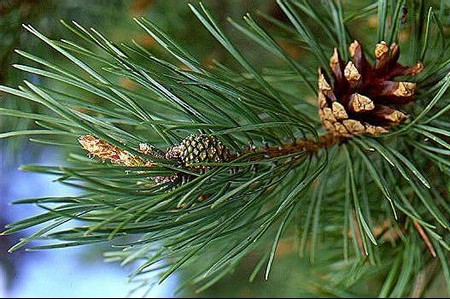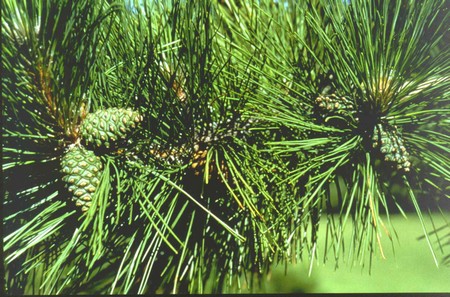The majestic evergreen scotch pine has been revered for centuries in many parts of the world for its symbolic significance and medicinal value. It also has great economic value as the straight long trunks make excellent timber, its resin and turpentine oil are good solvents and are used in paints and varnishes.
In Greek mythology the pine tree belongs to the goddess Cybele, mother of the gods. Her consort was a shepherd named Atys, the guardian of her temple from whom she obtained a vow of celibacy. However, Atys fell in love with another, named Sangaris. Cybele turned him into a pine tree to prevent him from killing himself and afterwards sadly mourned the loss of her unfaithful lover under the branches of the tree, until Zeus promised her that the pine would remain forever green.
As an evergreen tree the pine symbolizes immortality and the undying spirit and was often used in funerary and mourning rites. In China pine trees are planted on graves to strengthen the soul of the deceased and save their body from corruption.
The Greeks also dedicated the pine tree to others of their gods, to Zeus and Artemis, Jupiter and Venus, to Neptune because the first boats were made of pine, to Bacchus as pine cones were put into vats to flavour Greek wine, and to Pan. Pan seduced one of his nymphs, Pitys, who preferred him to Boreas, god of the North wind. Boreas in a jealous fury flung her about, crushing her limbs, and so Gaia transformed her into a pine tree to escape his wrath. Since then pine has been a symbol of pity.
The pine also symbolizes uprightness, straightness, vitality, strength of character, and because it grows so high, the connection between earth and heaven. It is an emblem of Confucius to the Chinese and represents longevity, courage, faithfulness and constancy in adversity. With the plum and the bamboo it is one of the three friends of winter in Japan, used in New Year celebrations:
Hear the Pine: may your prosperity be as constant as the greenness of my mande, and may your friends stand as 1 do, steadfast against the adverse winds of the world. Hear the Bamboo: may your lifetime be as long as mine and may you know the joy of living abundantly.
Hear the Plum: may your hopes rise fresh and strong like the young shoots that spring from my rugged trunk and may your life flower with loveliness.
In cold winter months, particularly, the pine is a favourite subject of Japanese artists in association often with the crane and the tortoise. In flower decorations the thick gnarled branches are used to represent a strong and happy old age. In Indo-European symbolism, the pine cone represents good fortune and fire, the masculine creative force and fecundity, and the cones were carried to increase fertility and to bring a vigorous old age.
Herbal remedy
Pine is an excellent remedy for the lungs. It liquifies and helps to expel bronchial phlegm and clears the head of congestion. Its antiseptic and anti-inflammatory action is recommended for treatment of respiratory infections, colds, coughs, flu, sore throats, bronchitis and pneumonia. It has also been used for tuberculosis. Its antispasmodic action in the chest will help relieve asthma and a harsh, tight cough. Pine also strengthens the digestion, and has a tonic revitalising effect generally. It can be given to those suffering from mental, physical or sexual depletion and from adrenal insufficiency as it has a stimulating effect on the adrenal medulla and cortex.
Pine is also a good remedy for the urinary system; it helps to remedy infections and the discomfort that accompanies cystitis. By aiding the elimination of toxins via the kidneys it will help in arthritis and gout, and due to its anodyne properties it may help to relieve headaches and toothache.
Externally, the resin and oil have been used in liniments to rub into painful joints and aching muscles and to increase the circulation. The tar is used in lotions for skin problems, such as ringworm.
Aromatherapy oil
Pine oil, obtained from steam distillation of the needles, is used much like the herbal remedy. It can be added to massage oils and rubbed into arthritic joints and will help to detoxify the body through its diuretic effect. It makes an excellent inhalant for respiratory infections, coughs, colds, catarrh and sinusitis. It can be used preventatively to keep infections at bay. Its antiseptic action extends to the urinary system where it can be used for urinary infections — pyelitis, cystitis and prostatitis.
When used in the morning, pine’s tonic and invigorating properties will help wake you up, enliven the mind and alert the senses. At the same time pine is calming and refreshing and can be used for exhaustion, debility, anxiety and stress-related problems. It is warming and strengthening, particularly in winter as it stimulates the circulation. Rubbed into the skin, pine will act as a good insect repellent and deodorant. It has a particular application to excessive perspiration. It can also be rubbed into the hair to clear headlice, and into the skin to repel fleas and scabies, but only when diluted in a base oil as it can sometimes cause irritation if used neat.
Homeopathic remedy: Pinus
Pinus works particularly on the bronchial and urinary systems and the joints. It is prescribed for feelings of oppression in the chest and a sensation that the chest wall is thin and could easily give way. There is burning in the sides of the chest. There may be swollen glands and fever with chilliness and a pale face, alternating with heat and flushing. There may be burning on urination and difficulty passing water. Pinus is also indicated by rheumatic, gouty or paraly tic pains in the limbs, bones and joints, with stiffness. There may be emaciation in the lower limbs, and weak ankles in children who tend to be late-walking. A Pinus person may feel anxious or despondent, the mind feels dull and they are unable to think clearly. They may undertake many things which they don’t finish. They tend to feel worse on exertion, from touch, in the morning and in the evening.
The flower essence
Pine is the Bach blower Remedy lor guilt and for those who feel guilty either about recent events or for just being alive. Such people cling to their guilty feelings which can affect their whole outlook on life, taking away their joie de vivre, and their energy. They tend to set high standards for themselves and feel dissatisfied when they cannot live up to them perfectly. They blame themselves for not doing better; they can even blame themselves for the mistakes of others. The pine child will be the scapegoat in the class who uncomplainingly accepts punishments for the misdemeanours of others. Enable to forgive themselves, pine people unconsciously put themselves in situations designed to punish them, such as unrewarding relationships with inconsiderate partners or friends.
The flower remedy helps people to accept their faults and not cling to them. It enables a greater understanding of human nature which is not perfect and allows light back into the lives of people who can learn to forgive themselves.

